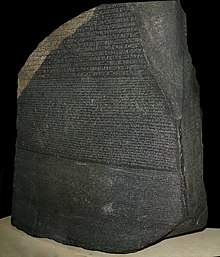
Back Skryfkuns Afrikaans Escritura AN लेखन ANP كتابة Arabic ܟܬܒܬܐ ARC Escritura AST लेखन AWA Qillqa Aymara Yazı Azerbaijani یازی AZB

Writing is the act of creating a persistent representation of human language. A writing system uses a set of symbols and rules to encode aspects of spoken language, such as its lexicon and syntax. However, written language may take on characteristics distinct from those of any spoken language.[1]
Writing is a cognitive and social activity involving neuropsychological and physical processes. The outcome of this activity, also called "writing", and sometimes a "text", is a series of physically inscribed, mechanically transferred, or digitally represented symbols. The interpreter or activator of a text is called a "reader".[2]
In general, writing systems do not constitute languages in and of themselves, but rather a means of encoding language such that it can be read by others across time and space.[3][4] While not all languages use a writing system, those that do can complement and extend the capacities of spoken language by creating durable forms of language that can be transmitted across space (e.g. written correspondence) and stored over time (e.g. libraries or other public records).[5] Writing can also have knowledge-transforming effects, since it allows humans to externalize their thinking in forms that are easier to reflect on, elaborate on, reconsider, and revise.[6][7][8]
- ^ Harris, Roy (2000). Rethinking Writing. Bloomington IN: Indiana University Press.
- ^ Smith, Dorothy E. (2005). Institutional Ethnography: A Sociology for People. Lanham, MD: Rowman & Littlefield. pp. 105–108. ISBN 978-0-7591-0502-7.
- ^ Ong, Walter (1982). Orality and Literacy: The Technologizing of the Word. London: Methuen. ISBN 978-0415027960.
- ^ Haas, Christina. (1996). Writing technology: Studies on the materiality of literacy. Mahwah, NJ: L. Erlbaum Associates.
- ^ Schmandt-Besserat, Denise and Michael Erard. (2008) "Origins and Forms of Writing." Handbook of Research on Writing: History, Society, School, Individual, Text. Charles Bazerman, ed. New York: Lawrence Erlbaum Associates, 7–21 [21].
- ^ Emig J (1994). "Writing as a mode of learning". Landmark essays. Taylor and Francis Groups. ISBN 978-1003059219.
- ^ Estrem, Heidi. "Writing is a Knowledge-Making Activity." Naming What We Know: Threshold Concepts of Writing Studies. L. Adler-Kassner & E. Wardle, eds. Logan: Utah State University Press, 2015: 55–56.
- ^ Winsor, Dorothy A. (1994). "Invention and Writing in Technical Work: Representing the Object". Written Communication. 11 (2): 227–250. doi:10.1177/0741088394011002003. S2CID 145645219.
© MMXXIII Rich X Search. We shall prevail. All rights reserved. Rich X Search